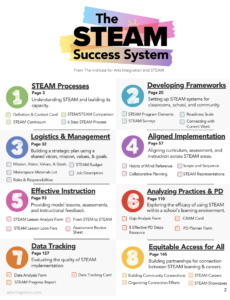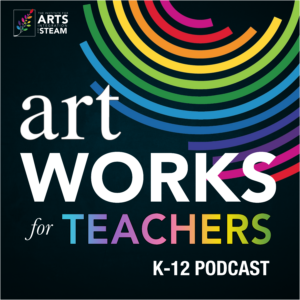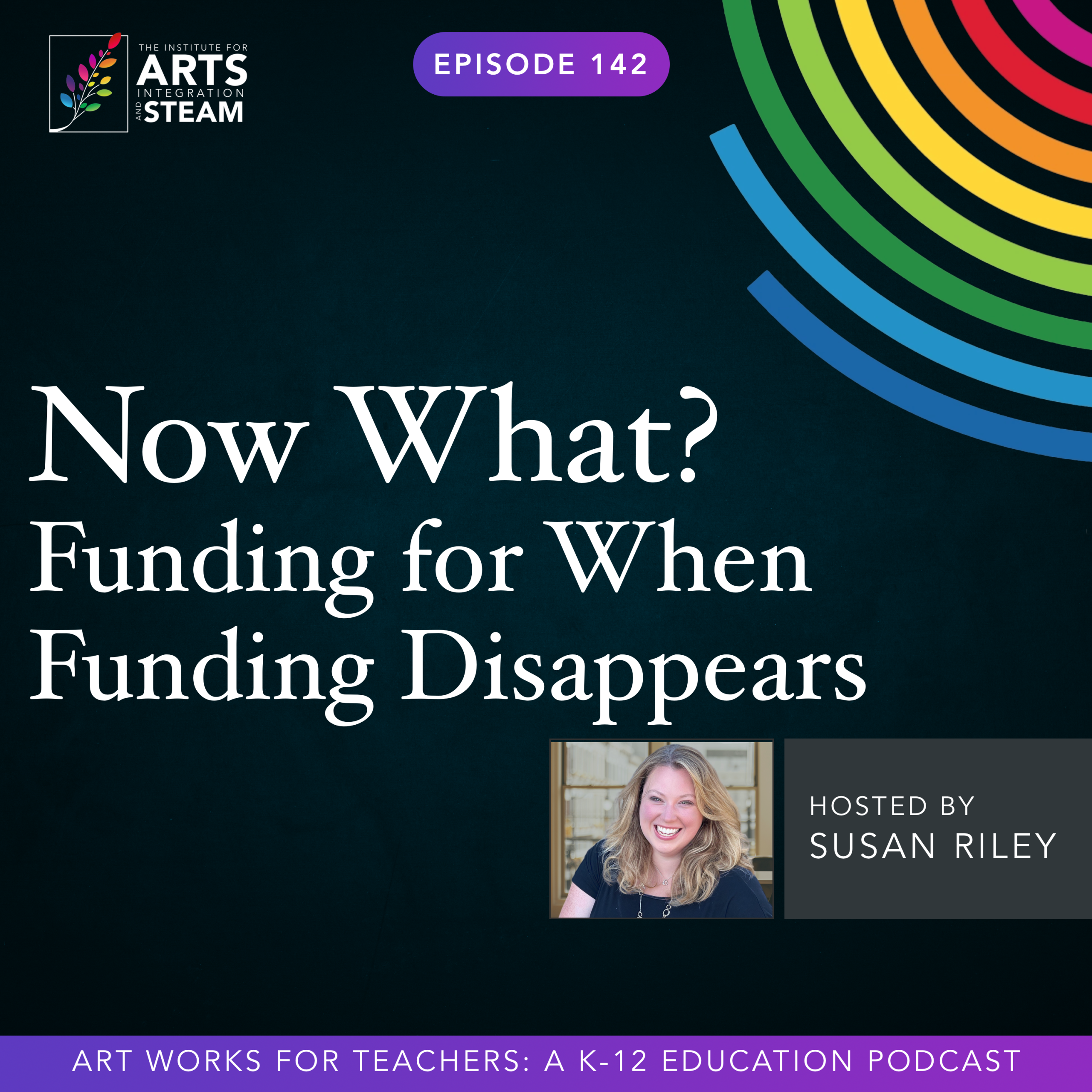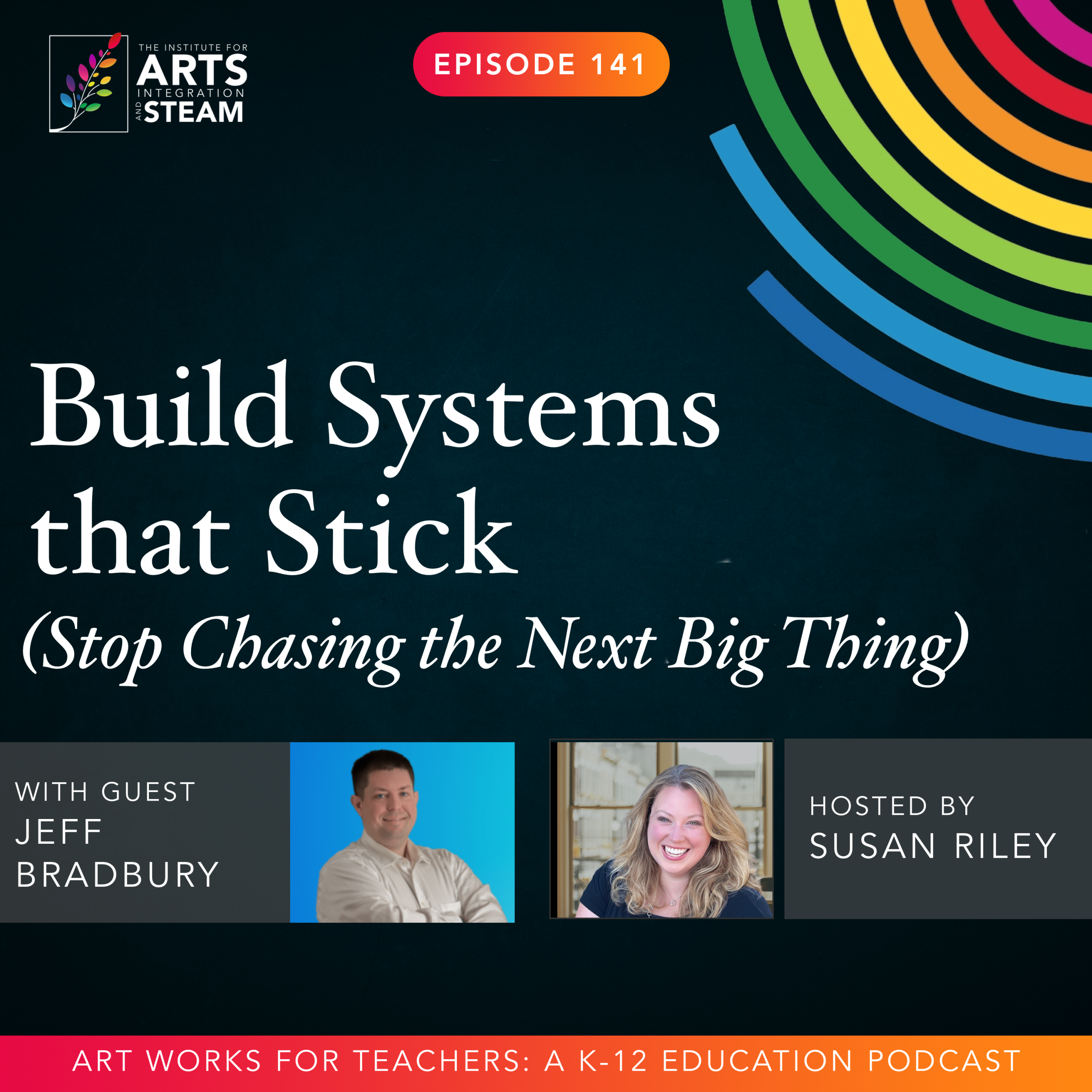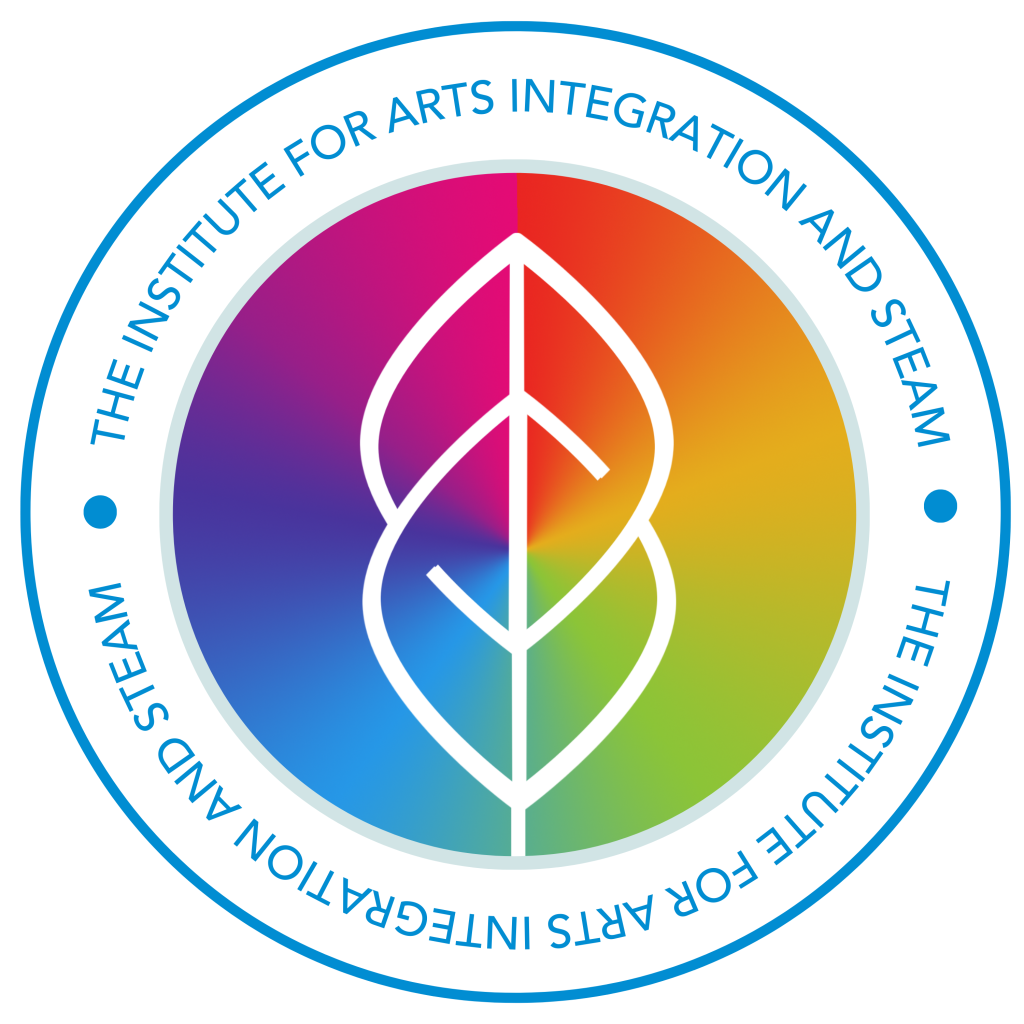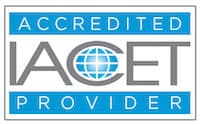ART WORKS FOR TEACHERS PODCAST | EPISODE 106 | 35:19 MIN
The Secret to STEAM Succes
Learn more about the STEAM Success System.
Hey there friend and welcome back to another episode of Artworks for Teachers. I’m your host, Susan Riley. And today is just you and me friend. Today we’re headed into yet another practical episode. You know, these are some of my favorites. While I love interviewing change makers and leaders and artists and educators and authors, and they expand our horizons so broadly and I appreciate them so much, sometimes, what I’m really yearning for as an educator is just tell me how to do it, right? Give me the practical steps that I need. And today, that’s exactly where we’re gonna focus, specifically around the area of STEAM. Now, I gotta tell you, sometimes I have this interesting conversation with colleagues in the field, and many of them, talk about the cyclical nature of arts integration and STEAM, right?
Quick fact, when we were naming the organization, originally, you know, we were Education Closet, and that came from the idea that my arts integration supplies were all in an education closet. And our organization actually started as a blog, so that’s what I had called the blog, was the Education Closet. But as we grew and our programming grew, we needed to become and transform into the Institute, which is what we’re known for now. But when we were coming up with the name,
We started with the Institute for Arts Integration and the Arts Integration Institute. We played with that a bit. And our team very much went back and forth on should we add STEAM to this? Because a lot of what we do is focus on arts integration and we believe that STEAM and our method and approach to STEAM is really based on an arts integrated approach to STEM and the arts together. So should we have STEAM in the name or not?
And at the time, it was a very big heyday for STEAM. STEAM was everywhere. It felt like the big buzzword, right, was the talk of STEAM. And we ended up adding that to the name. So now our name is very long. The Institute for Arts, Integration, and STEAM. But I said to our team, I said, if we’re going to include it, we also need to ensure that we have the resources and the tools around what that means. And it can’t just be thrown in there because it’s a buzzword. It actually has to mean something.
And so we have worked really, really hard to ensure that we have resources for schools who want to approach either arts integration or STEAM, or perhaps try to merge both together. But it’s funny because from a 30,000 foot view, when we’re looking at what schools are interested in, what they’re leaning towards, and where educators are really headed and looking at trends, STEAM has been on a downward trend, my friend, for the last, I would say probably four or five years. It’s really, it kind of hit and exploded for a long time and now has quietly kind of receded a bit. Arts integration very much came back into the forefront, right, during COVID and right after. It’s still very much a topic where people are excited and interested and we see a lot of grant dollars moving that way, to support arts integration efforts. see an increase in arts integration certification candidates. There’s a lot going on with arts integration and I love that. And there’s a lot of exciting things happening in the field of arts integration and trends that are evolving. But it’s been really quite interesting to think about where STEAM is headed. And I just got back from working with several states.
who are working on their STEAM implementation plans and getting ready to roll those out statewide. And it’s always funny to me how slow education can move, right? We all know this. But one of the things that really struck me during that meeting with those state level teams was how confusing the STEAM process can be. I think at this point in time, we’ve gotten to the point where we all understand a general definition of what STEAM really is. That it’s not just a cute art project on top of a design thinking challenge, right? It’s not the marshmallow challenge. It’s not painting a race car and focusing on the design of the race car and then just putting paint on it to make it look pretty. We know that those things are not STEAM and that STEAM is really about problem solving, creative thinking, and getting curious about the world around you and how the arts can be an equitable partner to that and teaching those things at the same time, right? I think we’ve all got an understanding of what STEAM is, but once you’ve got that foundational understanding, then people kind of get you to give you this deer in headlights look, like where do I head next? What’s the next thing that I have to do? Who do I need to engage? I’m having some trouble with buy-in. I don’t know what to buy.
How much of a budget should I have for something like this? How are we going to share this with parents? What about all the other things that teachers need to do? How are we going to weave this on top of everything else? Is this a new initiative? Are we weaving this into something else? All of these questions start bubbling to the surface, and they come fast and furious. And so once the questions start bubbling, and you can’t get them to stop, suddenly it’s like this paralysis happens of I don’t know where to go next. So I’m going to go look for either something to buy to say that I’m working towards STEAM or I’m going to look for a program that will say this is STEAM and will certify me as such. And what we have found with that over the last couple of years is that A, people who are certifying schools as STEAM schools are really only versed in STEM and they don’t really know what they’re looking for with the exception of states who have identified really a foundation of STEAM like Georgia, Ohio. Those kinds of state certifications are fabulous, but there are private entities out there who are certifying schools in STEAM and they have no idea what they’re actually doing. And the certification process is really quick.
And all you have to do is essentially pay for it and renew your payment and you’re a STEAM certified school, which doesn’t really add value to your teachers or your students. Or if people just go and buy the stuff, right? Then they have all the stuff, but they’re not getting any results from students using the stuff because the educators who have to like teach the students with the stuff, they don’t know how to use the stuff and make it pedagogically work in a way that deepens student learning. And so you have these things like makerspaces that are not being used, or if they are being used, they’re being used for quick little projects that are great, but what did the students actually learn in terms of connecting STEM and arts areas together? We’re not really sure about that, right? So we see all of this happening and it’s lot of frustration, right? But let’s be real. Teachers and administrators do not have time to take another course or to go get certified themselves. It takes a long time to go through those things. And we’re all overwhelmed. We’re all busy. We all have a lot of things to do. Right. So these are the kinds of questions that we start to see with STEAM. And I’ve had a lot of people recognize over the last two years that our organization is really focused on moving the shift to arts integration. We haven’t really been talking a lot about STEAM. But
That doesn’t mean that we haven’t been thinking about STEAM. Oftentimes when we’re quiet, it’s because we’re thinking and researching and trying to pull that thread together to help something, to create something that was gonna help educators actually move the needle. And that’s what we’ve been doing with STEAM. And now we have something that I think is really gonna help you. And so in today’s episode, all of that is to say that I wanna share with you. The secret, the secret things that we know are gonna actually make STEAM applicable to you, easy to use, something that you can start to implement right now and see actual results. Things like 10 % improvement in your reading scores, 10 to 15 % improvement in your math scores, even higher in your science scores and let’s not forget about special education populations and students, who are our English language learners, those populations can move the needle up to 20 % as an increase in their achievement scores in a year or less using the secrets that I’m going to share with you today. Okay, so I’m so excited to share this and I hope that you’re ready to take some notes because we got you. All right, now.
As I’ve started to be thinking about STEAM a couple of years ago and thinking about all of these problems that we’re starting to see, right, especially after COVID and people couldn’t use the printing machines or the Lego labs because students were touching them all, right? We couldn’t have that, not during COVID. So a lot of those things started to sit empty and we started to see this movement away from STEAM. We started to understand that the process is overwhelming. and it feels like we don’t know where to start and all of these other issues are happening. What I realized is that people need a step-by-step kind of process because it’s like building with Legos. And this is completely fascinating to me because, you know, so many schools have Lego labs, as I was touring a school a couple of years ago, a school was taking me on a visit and they showed me their Lego lab. And as I was looking at the Legos, I was…
I saw that these students, some of them had built these very elaborate kind of castles or houses and it was a part of a project that they had been working on. But I thought, I said to the teacher, was like, did they create those all by themselves? And she said, no, no, no, no. They use the directions from the kits to get started with those and to actually build those. We’re using that as an example of them creating their own directions to create their own houses. And I was like, well, that’s a phenomenal project.
Right? But as I kind of looked at these castles and these elaborate structures and components, and I realized they had step-by-step instructions for how to build those things. Right? And while you’re having the step-by-step instructions, you will see success. Right? If the teacher had started with a bunch of Legos in the middle and had a picture of the castle and said, build that. without any instructions at all. Would it have been overwhelming to that child? Yes. Would it, would they have maybe started in the wrong spot? Yes. Would they have selected, Legos to put together that didn’t actually work together? Yes. would it have been really, really frustrating, time consuming and a waste? Yes. Right. And as I was like kind of thinking about that, I thought that’s exactly, exactly what is happening with STEAM right now everywhere in schools all over the place. Right? It’s like you took a Lego box with a beautiful castle in the front that you were going to create, dumped the box out, hid the directions and said build that. How in the world is anybody supposed to do that? Right? With any kind of success. It’s a shot in the dark and that’s expensive.
And quite honestly, we don’t have the time or the money to waste in education. Tinkering around like that without any kind of instructions. Now, once you have the instructions, you would be able to build the castle the way it looks on the picture, right? The way you want it to be. You would start in the right place with the right tools, with the right sequence. You would then be able to maximize your time because you know exactly what goes where and when, and how, right? You would feel successful right at the top and you would see the result right away. Yeah? Wonderful. Once you have that, once you’ve had that experience of going through that, then could you modify it? Yes. Could you, once you understood that whole process, could you play with it and maybe start again and design your own like the child in that class was going to do? Yes, right? But first you need the sequence.
And so as I was looking at that, my brain started churning and I thought that that is what our educators and our school leaders and our school systems and our organizations, that’s what they need in order to build the dream STEAM programs that they want to build the castle. Right. And so what that turned into is what’s called our STEAM success system.
Now today, I’m going to share with you the eight steps that are included in there and why they’re important. This is your roadmap. Okay. Now I’m giving you the sequence. I want you to take this and run with it. If you would like help and support and like a cheat code for it with the resources and the templates and all of the tools that you would need, we have a system that you can buy for that and that would be great. But you don’t need to if you are like if you’re facing a zero dollar budget and you need to get started right now. You can just know these eight steps and then work your way through them. Will it take you a bit longer? Yeah. And will it look as pretty as with the templates that we have? No. But will it work? Yes. And that is my goal for you today. So here are the eight steps that we need to do in this order in order to see success with STEAM. The first one,
Many people would think is going to be like your envisioning step, right? This is when you’re crafting your mission and your vision and your values and your goals. Those of us who have been in education for more than five years have been through this cycle. Yes. but that’s actually not your first step. Many people get that confused. You actually can’t do that step until everybody in your school or your district or your group, wherever you are building this thing, you have to get everybody on the same page. They all have to understand what is STEAM, what it is not, and the process that’s involved in actually implementing it. You have to know those things before you can do any kind of visioning process, right? Because otherwise you might envision the wrong thing, right? So step one is simply STEAM processes. What is STEAM? What’s the foundation of STEAM? What is it? What is it not?
The difference between STEM, STEAM, and arts integration, and when you use STEAM, when is it appropriate, right? Having that foundational knowledge, that’s important. That’s your first step. So you get everybody on board. You might end up giving out some stakeholder surveys. You might want to save that until step two, it bridges. But getting everybody involved on the STEAM continuum, knowing where you are with STEAM and where you need to go.
That is your foundational step. Step number two is in developing your frameworks. So now that you know what STEAM is, and everybody’s on the same page with that, then you start to use things like the STEAM program elements. So knowing what those elements are. What are the things that you need to have in place in order for you to have a successful STEAM program? What systems do you need? What climate and culture do you need?
What PD would you need? Kind of outlining those things and knowing what those are. That’s important. Knowing how it’s going to connect with your current work so that it’s not one more thing, but that you can weave it in in a way that’s meaningful. Understanding your readiness for STEAM. We have something in the system called the STEAM Readiness Scale, where you just take a quick quiz and it will identify what level you’re on in the readiness scale as to know what do we need to do next, right, so that it takes away the fear of everything all at once. And then finally, surveying those stakeholders. So knowing what do our parents think about STEAM? What do our teachers think about STEAM? And what do our students think about STEAM? What are their current perceptions? So that you can then move into step number three. This is your envisioning step. This is called logistics and management. And this is when you do all of the big brainstorming. So you decide your scene vision, your mission, what your values are, what your goals are for the program so that you know what to hit. It’s when you start to design your budgets. So now that you know what those goals are, you have budgets available to you, how are we gonna divvy out those budgets? What are the roles and responsibilities of the people on your team? And how do you build that buy-in, right? How do you get that going? From there, you’re gonna move into step four, which is called the implementation step. So now you know what STEAM is, you have some frameworks available, you know how ready you are and what your whole community thinks about it. You have a plan for how you wanna implement STEAM long-term and a vision and goals for what that looks like and a budget. Now, now you gotta start looking at, okay, how do we begin to implement? And so you have things like understanding, the larger lesson design process, what does your curriculum look like and where can we implement STEAM authentically in that curriculum. You’re to start looking at scope and sequences. You’re going to start looking at the collaborative planning process and how our habits of mind also interact and prepare us for implementation. By the way, I am referencing this sheet right here of the eight steps. We’re going to include this as your download today.
Because even this checklist is going to help you so much as you begin to do this work. Once you know how you plan to implement it, okay, now we can actually start to get into instruction. This is step number five, looking at what effective STEAM instruction looks like. So you know what look for is, what you’re looking for in a STEAM lesson. And there are a series of things to want to look for. Like you want to be able to see aligned standards in a lesson.
You want to see equitable access to the arts and the STEM content. You want to be able to see that students are engaging in problem solving and hands-on learning. These are all components of effective instruction, and so you want to make sure that you start monitoring that. How many lessons do you want to implement per year that are STEAM to get started? This is the stage where you decide that, right? And how are we going to look for those? Are we going to have some peer reviews? How are we going to decide that step?
Notice, by the way, these are bite-sized steps. We’re not doing this all at once. You’re taking it one step at a time, just one Lego brick after the other to build your castle. So now that you know your implementation and what that’s going to look like, you have your effective instruction down and everybody has started to work with Steam. They know what it looks like. They’re tweaking things to make it their own and to make it as effective as possible.
Now you can start looking at analyzing your best practices and you’re getting PD in the areas where you need some support. So as you’re working through your effective instruction, you’re going to notice, I need some PD in aligning the standards. I’m not quite sure how to do that. I need some support there. Or the teacher down the hall did this amazing STEAM lesson. Let’s have her share that best practice during our next staff meeting because that could help everybody else, right, and use that as a demo lesson. So in step six, you’re really looking at how do we tweak that effective instruction and make it even better and then provide the PD supports to allow our staff to continue to get better and evolve with their instruction. So that’s number six, almost there. Number seven is when we start to track data. Notice that we don’t start to track data immediately as we’re working on instruction, right? Because that’s going to make your instruction falter. Everybody freaks out when there’s data involved, right? Especially when we’re tracking data, people are like, I have to have it perfect. And they start really getting anxiety around the instruction. When you allow the instruction to evolve naturally and then have that PD step in the middle, that allows everybody to know this is a process. We’re not grading this yet. What we’re looking for is that we’re getting better.
With that mindset then, we can move into data tracking and decide what kind of data do we want to look at? Maybe it’s not test scores. Maybe the first set of data that we look at is just the amount of hands-on engagement our students are participating in during the day. Like how often are students engaged during your lesson and keeping track of that over time and see how if that increases as you do more with STEAM activities.
That could be a great piece of data to track. You might want to track how involved is your community since you began working with STEAM and having STEAM event nights or showcases or ways that the community can participate in your STEAM program. That might be a good data metric to track. You don’t always have to track test data. It could be a wide variety of things. So in step seven, you’re going to decide for yourself, what data do we want to track and how to do that.
And then in step eight, final step is what we call equitable access for all. This is when you start looking at connecting STEAM to possible career paths, the community outreach, having members from the community who work in STEAM related fields or who pull together their work across disciplines and have them come in and share their experience with students, make this real world and tangible for students, so that they can envision themselves in the future in a career that could possibly be STEAM-based. So that’s when you start building that component in. We’re talking about STEAM Showcases and organizing your connection efforts and looking at how to build community connections that are long-term and lasting so that if you’re doing this with a grant, perhaps you work at fostering those relationships with local businesses so that when the grant ends, your businesses can help to shoulder some of the burden so that you can work together at building a long-term STEAM program that lasts after the grant ends. Those are the eight steps in that order to build the STEAM program that you’re dreaming about that is going to have the results that you need and the results that, quite honestly, our students deserve. When you implement it this way,
Teachers are going to be happier because you’re not overloading it all at once. You’re doing it little by little and you’re honoring them where they are. You’re going to get more buy-in because you’re doing this in a strategic way and everybody understands where you are in the process. And it’s not just one more thing that there’s a purpose behind it. And you’re building relationships with your community at the same time. These eight steps, all you have to do is go through these eight steps in that order and I promise you that wherever you are in your STEAM efforts, if you’re just beginning or if you’ve had one for a really long time but it’s stagnated, these eight steps in this order is going to help you to see immediate results with your students and with your staff. And like I said, if you’d like additional support with that, we do have our STEAM Success System that you can take a look at. That’s over at artsintegration.com forward slash STEAM dash success, that’s also up on the menu so you can always find it there as well. And we’ll put a link to it in the show notes. But as I said, if you just want to start from scratch and you want to do it on your own, that’s cool too. Go download our freebie today so that you have the eight steps available to you at any time. I hope this practical overview of the STEAM success process has been helpful and that just kind of thinking about tinkering with STEAM. If you’ve been on the edge or if you’ve been, if you had a STEAM program and it’s kind of fallen off a little bit, or if you’re in the middle of it and you just need to get really excited about it, that these eight steps can help you the way that I’ve seen them help so many other schools build and sustain and grow their STEAM efforts. So thank you so much for tuning in today. Hope it was helpful. I can’t wait to be with you again next week.

